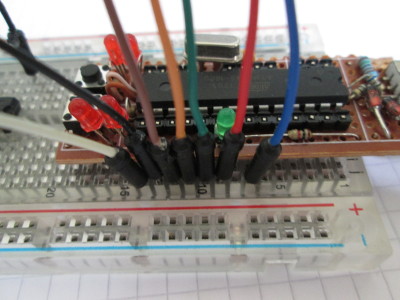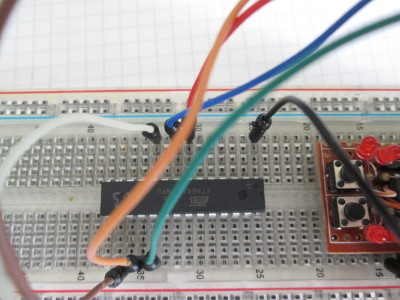Firmwares
- In order to test the boards solder joints and connections, this firmware first rotates all red LEDs. (Check for shorts/cold joints)
This rotation will stop after about 1sec, when a proper host (conntected to the USB) is found. This step won't require any drivers, since USB-HID is used. However, if no USB host is found, or the USB host doesn't support simple boot HID protocol: Cycling the leds never will end. - If an USB connection is detected, all four red LEDs blink for about one second and an animated countdown for about 20sec starts.
(The leds stop flashing one after another until no one is left.)
An USB HID keyboard is emulated during this period: - If the PROG button is pressed (or PD6 is grounded) during the countdown, the countdown is reset.
When PROG (PD6 from GND) is released then, a greetings message starts typing while the leds are cycling again. (This time inverted.) - If the keyboard LED state (NUM-, CAPS- and SCROLL- lock) is changing, the countdown is reset, too. However a message won't be typed.
- At the end of the countdown, the bootloader is invoked to enter PROGMODE: This default firmware then has stopped execution and the board is ready to receive new firmware.
- In cases an error occurs, two diagonal LEDs are flashing alternating, all other functions stop and the USB becomes disconnected.
93cX6 eeprom programming
Please connect CS <--> PB2 (SS) , DI <--> PB3 (MOSI) , DO <--> PB4 (MISO) , SK <--> PB5 (SCK) and make sure eeprom has proper Vcc, GND and ORG pulled to GND
USBasp programming
precompiled (atmega8) firmware: here, Rev.2 (or older): here
ATmega328P tinyUSBboard version as USBasp programmer: here
(for other AVRs: atmega328, atmega168P, atmega168, atmega88P, atmega88)
Improved version! (Provides 4MHz rectangular clock at PB1 and implements software switchable ISP speed: -B10 in avrdude)
precompiled firmware: here , Rev.3 (or newer): here
for ATmega328P tinyUSBboard version: here
Other bootloader
- tinyUSBboard with default and recommended bootloader "USBaspLoader": Simply install one of these updates
- tinyUSBboard with BootloadHID (patched version) instead of USBaspLoader as bootloader
WARNING: When BootloadHID is on the board, your usual programming software may not work!Migration firmware: here , Rev.3 (or newer): here
You then have to use some special "bootloadHID" tool.
ATmega328P tinyUSBboard version: here - tinyUSBboard with AVRUSBBoot instead of USBaspLoader as bootloader
WARNING: When AVRUSBBoot is on the board, your usual programming software may not work!Migration firmware: here , Rev.3 (or newer): here
You then have to use some special "AVRUSBBoot" tool.
Example firmwares
- tinyUSBboard repository collection (snapshot 20150808) with resolved symlinks (see github page)
- random RGB walk - RGB-LED fade at PINs PB1,PB2 and PB3 (see Arduino source)
- avr-threaddemo (Makefile, source)- tinyUSBboard using avr-thread lib (very interesting)
- You can download libavr-thread-v1.3 here.
- Please use this patch to extend AVR4 and AVR51 architectures to the library.
- Documentation can be read here.
- I also precompiled the library here (plus header)
- AVR C demo with PWM (for RGB-LED), analog read and two line hd44780 LC-Display (source code)
- As analog input PIN23 (PC0/ADC0) is used
- PIN15 (PB1/OC1A) is used for 8bit fast PWM red (R)
- PIN16 (PB2/OC1B) is used for 8bit fast PWM green (G)
- PIN17 (PB3/OC2) is used for 8bit fast PWM blue (B)
- The hd44780 LCD data pins D0 to D3 are not used
- The hd44780 LCD data pins D4 to D7 are connected to PIN25 to PIN28
- The hd44780 LCD E, RS and RW are connected to PIN6, PIN11 and PIN14
- You can download precompiled hex-files for LCD and without LCD here.
- As usual for this kind of examples the code is linked to start at address 0xC00 to conserve upper flash memory. (See avr-assembler files for: LCD and without LCD)
- VUSB skeleton/example with corresponding linux, windows (delphi) and platform independent GTK libusb program
- use onboard USB interface to exchange data with your computer
- for Windows you may need at least GTK+ runtime installed to enable GUI
- available as ZIP compressed source code
or as BZIP2 compressed tar source code


